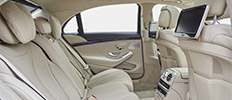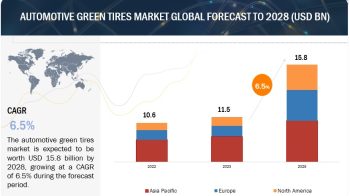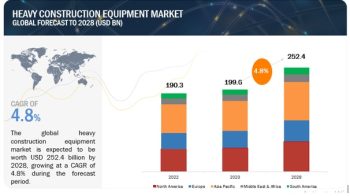
The Automotive Interior Market is estimated to be worth USD 153.5 billion in 2022 and is projected to reach USD 201.2 billion by 2027, at a CAGR of 5.6% during the forecast period.
Technological advancements in current automotive interior components, along with the increasing trend of connected and autonomous vehicles, are further expected to drive the automotive interior market.
The automotive industry is currently under constant pressure to adapt to new changes due to technological advancements and end-user preferences. Vehicle interiors are key areas that have witnessed a rapid change due to various factors such as the consumer demand for safety and comfort, preference for fuel efficiency, and increasing competition within the industry. OEMs strive to provide vehicles with good interior styling, comfort, and safety. They also focus on reducing the weight of the vehicle by using lightweight, cost-effective, and highly durable materials in the design of components. There have been many innovations in the automotive interior market recently, such as the head-up display, advanced gesture controls, haptic feedback, smart seating system, lighted headliner, and OLED lighting. To cater to the increasing consumer demand for customized and technologically advanced vehicle interiors, companies are constantly developing superior products with enhanced features.
Some of the key market players include Continental AG (Germany), Faurecia SA (France), Grupo Antolin (Spain), Marelli (Japan), Magna International Inc. (Canada), Adient (US), Toyota Boshoku (Japan), Visteon (US), Dräxlmaier Group (Germany), Panasonic Corporation (Japan), and Yanfeng Automotive Interiors (China), among others.
Request FREE Sample Report @ https://www.marketsandmarkets.com/requestsampleNew.asp?id=10199544
The COVID-19 pandemic has presented an unprecedented challenge for the automotive interior component providers as major OEMs partially or completely suspended vehicle production in major automotive markets. As the severity of the pandemic increases in Europe and North America, major automotive interior providers had lost significant revenue in 2020 and in 2021.
The Asia Pacific is estimated to have a significant market share by 2027, followed by Europe and North America. The growth of the automotive interior market in Asia- Pacific is expected to be driven by the adoption of advanced interior components such as HUD, centre stack, and lighting in the economy and commercial vehicles. The major growth drivers for the Asia- Pacific automotive interior market include the growing demand for technology, the rising need for a safe and secure driving experience, and an increase in the development of connected cars. Automotive interior components and solution providers such as Continental (Germany), Hyundai Mobis (South Korea), Denso(Japan), Panasonic (Japan), and Robert Bosch GmbH (Germany) are the major players in this region.
The passenger car segment is expected to be the largest automotive interior market. Passenger vehicles require high-quality interiors as compared to LCVs and HCVs due to end-user demand. The amount of money spent on quality, comfort, and styling of automotive interiors is higher in the case of personal use than commercial use of vehicles. Also, the increased disposable income in developing countries is driving the growth of the automotive interior market for passenger vehicles.
The autonomous segment is projected to be the fastest segment of the automotive interior market during the forecast period. The adoption of autonomous vehicles will grow worldwide due to the increase in demand for self-driving cars. The segment will also be anticipated to rise in the coming years due to an increase in the electrification of vehicle components and the use of smart automotive interior solutions that assist passengers in terms of comfort and safe ride. Also, technologically driven companies and OEMs are collaborating to make semi-autonomous and autonomous vehicles a safer mode of transportation, thereby engaging consumer curiosity.
Download PDF Brochure @ https://www.marketsandmarkets.com/pdfdownloadNew.asp?id=10199544
Recent Developments:
- In November 2021, Continental developed an innovative display solution called ShyTech Display that intelligently supports drivers in keeping an eye on all the important information at all times.
- In September 2021, Continental AG and Horizon Robotics formed a joint venture to focus on delivering better solutions for the Advanced Driver Assistance System (ADAS), which will be done by integrating new hardware, including antennas, radars, and sensors.
- In August 2021, Robert Bosch signed a collaboration agreement with Mahindra & Mahindra for the development of the Mahindra connected vehicle platform “AdrenoXConnect”. This platform will deliver seamless connectivity and enhanced user experience in Mahindra’s flagship SUV XUV700.
- In September 2021, Grupo Antolin inked an international collaboration agreement for the Air Move+ air purification solution with ZONAIR3D, an air purification system innovation firm. The partnership entails combining ZONAIR3D air purification technology with Grupo Antolin’s knowledge and skills in the development and integration of novel automotive interior solutions.
- In February 2022, Faurecia acquired 79.5% of Hella shares, including 60% of Hella shares from a pool of family shareholders, for approximately 52.1% in cash, 7.9% in newly issued Faurecia shares, and 19.5% as part of the settlement of the public takeover offer, which ended on November 11, 2021. This transaction implies a total investment of USD 6 billion (cash and shares).


